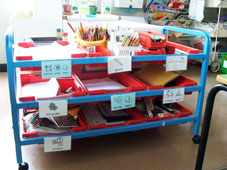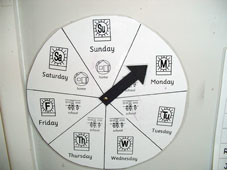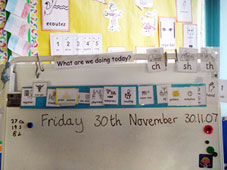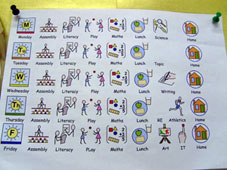Impact related to Every Child Matters
Staying Safe
: Being protected from harm and neglect
NB: Click on the images in each section to see larger versions
Examples of how symbol supported materials have helped pupils.
Understanding rules
Rules around the school site
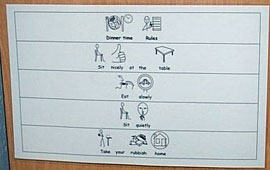
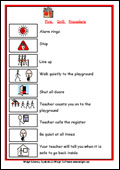 Symbolising
rules for pupils who are not able to read text enables them to understand
what is expected in a range of situations. The visual clue helps them
to remember what the rules are. Staff teach them the symbols initially.
Dinner time rules and Fire Drill rules both focus on aspects of safety
within school.
Symbolising
rules for pupils who are not able to read text enables them to understand
what is expected in a range of situations. The visual clue helps them
to remember what the rules are. Staff teach them the symbols initially.
Dinner time rules and Fire Drill rules both focus on aspects of safety
within school.
Rules in a Small Group
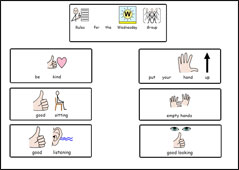 A
weekly social interaction group for 6 Year 5 pupils with communication
difficulties needed symbolised 'rules' so all members of the group understood.
The rules were put on the group's display board. At the beginning of each
session the member of staff reminded the group about them. After a few
weeks the two target pupils were self monitoring their own behaviour as
well as pointing out when other group members were not following the rules.
A
weekly social interaction group for 6 Year 5 pupils with communication
difficulties needed symbolised 'rules' so all members of the group understood.
The rules were put on the group's display board. At the beginning of each
session the member of staff reminded the group about them. After a few
weeks the two target pupils were self monitoring their own behaviour as
well as pointing out when other group members were not following the rules.
Time Out Rules
 These
rules were set up to support a pupil who was finding it very difficult
not to react aggressively in the playground when he felt angry about something
that had happened. This was a particular problem at lunchtime when the
break was longer. The 'rules' were initially agreed with the pupil and
the mid-day supervisor so everyone involved had ownership. At the beginning
of each lunchtime the mid-day supervisor went over the rules with the
pupil. Over half a term the number of angry outbursts reduced and because
of this agreed routine the situation was easier for the adults to manage.
The visual support and consistency of approach also made it easier for
the pupil to understand and accept the
These
rules were set up to support a pupil who was finding it very difficult
not to react aggressively in the playground when he felt angry about something
that had happened. This was a particular problem at lunchtime when the
break was longer. The 'rules' were initially agreed with the pupil and
the mid-day supervisor so everyone involved had ownership. At the beginning
of each lunchtime the mid-day supervisor went over the rules with the
pupil. Over half a term the number of angry outbursts reduced and because
of this agreed routine the situation was easier for the adults to manage.
The visual support and consistency of approach also made it easier for
the pupil to understand and accept the
sanctions.
Playtime and class rules- used to aid pupils understanding and for reinforcement
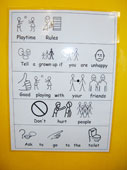
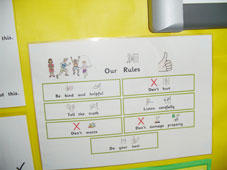 Left)
Playtime rules for Key Stage 2 pupils. Mid day supervisors would go over
these rules with some pupils at the beginning of each lunchtime play.
The symbols act as a good reminder of what is expected, and what to do
if you are unhappy. Some sites have rules displayed outside. Others laminate
small copies so staff can have then in their pockets for easy access.
Left)
Playtime rules for Key Stage 2 pupils. Mid day supervisors would go over
these rules with some pupils at the beginning of each lunchtime play.
The symbols act as a good reminder of what is expected, and what to do
if you are unhappy. Some sites have rules displayed outside. Others laminate
small copies so staff can have then in their pockets for easy access.
Right) Rules for a Year 1 class which were discussed and agreed by all.
Symbolised School Rules from Oak Wood Special School and explanation of the role of their School Council
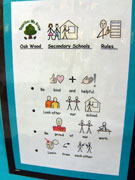
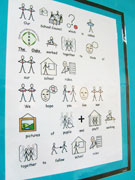 Oak
Wood Primary and Secondary Special School have used symbols widely around
their school site. This enables all their students to understand the school
rules, and other general school information.
Oak
Wood Primary and Secondary Special School have used symbols widely around
their school site. This enables all their students to understand the school
rules, and other general school information.
Rules for the Taxi
 Many
pupils have to spend a long time at the beginning and end of the school
day travelling in a taxi. Sometimes this can cause friction and result
in behaviour which is not safe. The image below shows visual support developed
for a group of four pupils who had such a taxi journey. They often 'fell
out' with each other during the ride and this system of rules and reward
helped to solve some of the problems! The rules were symbolised so that
everyone knew them: empty hands, good sitting, talk quietly, good listening
and be kind. Each day the escort would report to staff on the previous
days behaviour and pupils would get a tick for doing the right thing.
The chart at the bottom has three zones, gold, silver and red. Each pupil
has a picture of themselves on a little taxi. The taxi moved up or down
the zones depending on good or bad behaviour. Pupils who were in the gold
zone for a whole week had a reward.
Many
pupils have to spend a long time at the beginning and end of the school
day travelling in a taxi. Sometimes this can cause friction and result
in behaviour which is not safe. The image below shows visual support developed
for a group of four pupils who had such a taxi journey. They often 'fell
out' with each other during the ride and this system of rules and reward
helped to solve some of the problems! The rules were symbolised so that
everyone knew them: empty hands, good sitting, talk quietly, good listening
and be kind. Each day the escort would report to staff on the previous
days behaviour and pupils would get a tick for doing the right thing.
The chart at the bottom has three zones, gold, silver and red. Each pupil
has a picture of themselves on a little taxi. The taxi moved up or down
the zones depending on good or bad behaviour. Pupils who were in the gold
zone for a whole week had a reward.
Feeling comfortable in the environment
Communication Friendly Environments
Schools and settings can make their sites 'Communication Friendly' by having colour coded maps to help people find their way round and by symbolising any instructions such as how to get in the front door. Equipment in classrooms can be labelled using symbols and words so pupils can resource themselves independently - Section on CFE
Having the confidence to speak up
 Teachers
found that having symbol cards as prompts, children who were normally
reluctant to speak up, were much happier making a positive contribution
in a group situation.
Teachers
found that having symbol cards as prompts, children who were normally
reluctant to speak up, were much happier making a positive contribution
in a group situation.
Incident Narrative
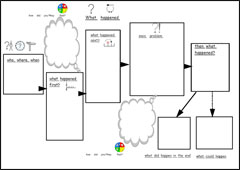 Giving
pupils a method of explaining something that has happened to them in a
visual way. This was set up to try to help pupils who were getting into
trouble in class and in the playground because they were responding inappropriately,
to go over what had happened with an adult. The pupil or the adult can
draw or write in the boxes. There are thought bubbles to comment on feelings.
It also enables discussion about how another reaction may have produced
a different outcome.
Giving
pupils a method of explaining something that has happened to them in a
visual way. This was set up to try to help pupils who were getting into
trouble in class and in the playground because they were responding inappropriately,
to go over what had happened with an adult. The pupil or the adult can
draw or write in the boxes. There are thought bubbles to comment on feelings.
It also enables discussion about how another reaction may have produced
a different outcome.
Understanding routines
There are many ways to support pupils understand the daily routine. Understanding 'what will happen next' often reduces anxiety and frustration.
Feeling safe in the Learning Environmen
t
Symbol supported resources make learners feel less anxious and allow them to develop into more confident students. The examples show:
a) Numeracy vocabulary in Year 6
b) Key Stage 1 weather vocabulary
c) Geography booklet about deposition - Year 6 and Key Stage 3



